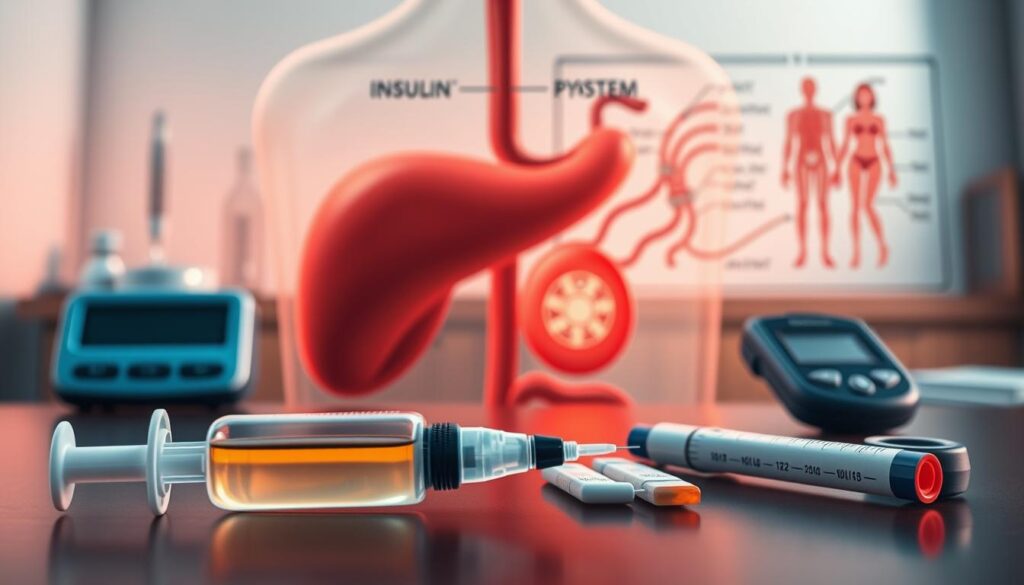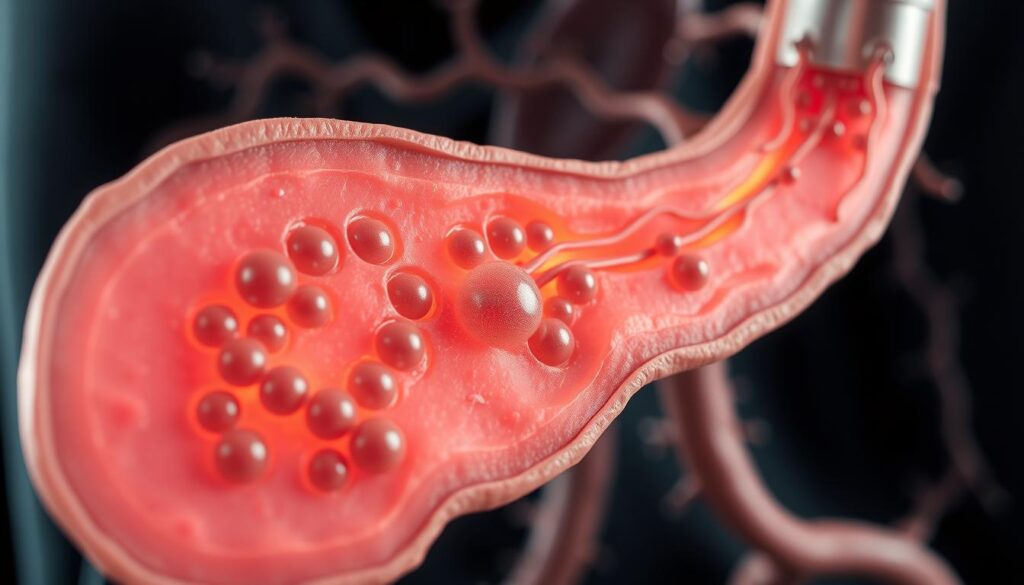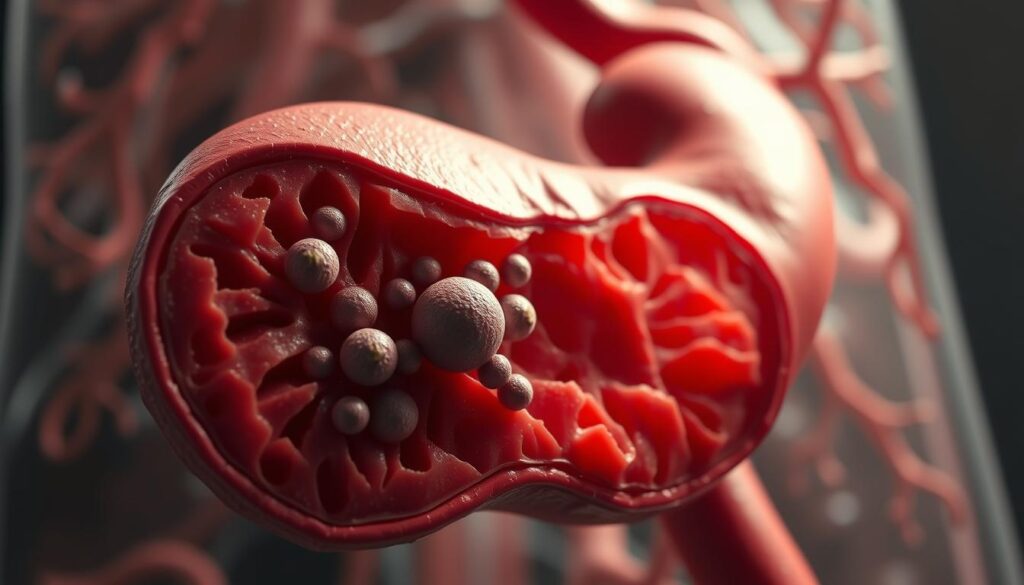Type 1 diabetes happens when your immune system attacks the beta cells in your pancreas. These cells make insulin. Without insulin, glucose builds up in your blood, causing high blood sugar. Knowing about type 1 diabetes is key to managing it.
Many people wonder what type 1 diabetes is when they or a loved one gets it. It’s a lifelong condition but with the right care, people can live well with it.
Table of Contents
Type 1 diabetes can start at any age, but it’s often seen in young people. Understanding it helps you manage your health. It’s an autoimmune disease that needs insulin to control blood sugar.
Key Takeaways
- Type 1 diabetes is an autoimmune disease that destroys the beta cells in the pancreas.
- Understanding type 1 diabetes is crucial to managing the condition and preventing complications.
- What is type 1 diabetes, and how does it affect the body, are questions that can be answered by understanding the role of insulin in glucose regulation.
- Type 1 diabetes explained, it is a condition that requires lifelong insulin therapy and continuous glucose monitoring.
- Early detection and treatment of type 1 diabetes can significantly reduce the risk of complications, including diabetic ketoacidosis.
- Approximately 1.25 million Americans are living with type 1 diabetes, and the incidence peaks in two age groups: between 4-7 years and 10-14 years.
- Family history increases the risk of developing type 1 diabetes, particular with a parent or sibling affected.
What is Type 1 Diabetes: An Introduction to the Autoimmune Condition
Type 1 diabetes is when the immune system attacks the pancreas cells. It sees them as harmful and destroys them. This makes it hard for the body to make insulin.
This leads to type 1 diabetes symptoms like being very thirsty, needing to pee a lot, losing weight, and feeling tired.
Knowing what causes type 1 diabetes helps in managing it. The pancreas’s insulin-making cells get destroyed. People with type 1 diabetes often have autoimmune thyroid disease too, affecting over 90% of them.
To manage type 1 diabetes, people check their blood sugar often and take synthetic insulin. They should see an endocrinologist at least three times a year. Understanding the condition and its symptoms is the first step to better managing it and improving life quality.
The Biology Behind Type 1 Diabetes
Understanding type 1 diabetes is key for good type 1 diabetes treatment. The disease happens when the body’s immune system attacks insulin-making cells in the pancreas. This means people with type 1 diabetes can’t make enough insulin, causing high blood sugar.
A type 1 diabetes diagnosis is made by looking at symptoms, medical history, and lab tests. Symptoms like thirst, urination, fatigue, and blurred vision can appear quickly. If not treated, type 1 diabetes can cause serious problems like heart disease and nerve damage.
Getting a type 1 diabetes diagnosis early and starting treatment is very important. Treatment includes insulin, healthy eating, and exercise. With the right care, people with type 1 diabetes can live active, healthy lives.

Getting a type 1 diabetes diagnosis and treatment is complex. It needs careful watching and management. By knowing about type 1 diabetes and working with a healthcare team, people can find a good treatment plan. This helps improve their health and well-being.
Recognizing Type 1 Diabetes Symptoms
Early diagnosis and treatment are key when living with type 1 diabetes. Symptoms can show up suddenly and need quick action. You might feel very thirsty, need to pee a lot, and eat more than usual.
Knowing the early signs of type 1 diabetes is important. These signs can come on fast, in just a few days or weeks. Some common symptoms include:
- Extreme thirst (polydipsia) and frequent urination (polyuria)
- Increased appetite, mostly in kids
- Unexplained weight loss, as the body uses fat for energy
- Fatigue, showing the body can’t turn sugar into energy
- Dry mouth and itchy skin, from not having enough water
Managing type 1 diabetes well means regular check-ups and talking to healthcare teams. Knowing these signs early helps you get help fast. This can stop serious problems like diabetic ketoacidosis. Living with type 1 diabetes means watching your health closely to stay active and healthy.

By spotting type 1 diabetes symptoms early and getting help, you can manage your condition well. Keeping an eye on your diabetes and managing it is key to staying healthy.
Living and Thriving with Type 1 Diabetes
If you have type 1 diabetes, you can live a long, healthy life. Around the world, about 8.7 million people live with this condition. In the United States, over 1.25 million people, including 500,000 kids, manage it.
Working with your diabetes team is key to thriving. They help you with insulin, glucose monitoring, and diet and exercise plans. With hard work and support, you can keep your blood sugar in check and avoid serious problems.
You’re not alone in this journey. Having a strong support system, like family and friends, or online groups, helps a lot. By focusing on your health and staying positive, you can beat the challenges and live a happy life.
FAQ
What is Type 1 Diabetes?
Type 1 diabetes is when your body attacks its own insulin-making cells. This makes it hard to control blood sugar. Without insulin, blood sugar builds up.
How does Type 1 Diabetes differ from Type 2 Diabetes?
Type 1 diabetes is an autoimmune disease. Type 2 is linked to lifestyle choices. In Type 1, the immune system attacks insulin cells. In Type 2, the body resists its own insulin.
What are the symptoms of Type 1 Diabetes?
Symptoms include being very thirsty and urinating a lot. You might also lose weight, feel tired, and hungry all the time. These happen because your body can’t control blood sugar without insulin.
How is Type 1 Diabetes treated?
Treatment includes insulin shots or a pump. You also need to check your blood sugar often. Eating right and staying active are key. Early treatment helps avoid serious problems.
Can people with Type 1 Diabetes live healthy lives?
Yes, with the right care, people with Type 1 diabetes can live well. There’s no cure, but new treatments and technology help manage the disease. This way, they can enjoy a good life.
How useful was this post?
Click on a star to rate it!
Share this article:
Meet Gluco 6
Blood sugar balance supplement
Tired of Type-2 controlling your life or worried that persistent high blood sugar may turn into something worse? Then yes, Gluco6 is right for you.
Gluco6 has already provided amazing blood sugar assistance for men and women in their 30s, 40, 50s and even 80s. Because it was formulated based on cutting-edge science and groundbreaking ingredients, Gluco6 is engineered to rapidly assist even the most erratic blood sugar levels.






